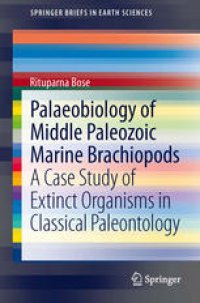
Ebook: Palaeobiology of Middle Paleozoic Marine Brachiopods: A Case Study of Extinct Organisms in Classical Paleontology
Author: Rituparna Bose (auth.)
- Tags: Paleontology, Conservation Biology/Ecology, Biogeosciences
- Series: SpringerBriefs in Earth Sciences
- Year: 2013
- Publisher: Springer International Publishing
- Edition: 1
- Language: English
- pdf
Fossil species appear to persist morphologically unchanged for long intervals of geologic time, punctuated by short bursts of rapid change as explained by the Ecological Evolutionary Units (EEUs). Here, morphological variation in Paleozoic atrypide morphology at the subfamily level (Atrypinae and Variatrypinae) from the Silurian and Devonian time intervals in the third Paleozoic EEU (~444-359 my) were investigated using relatively new techniques of quantitative modeling. The study explains how a group of closely related taxa in atrypide subfamilies exhibit morphological conservation through time in P3 EEU within the Eastern North America region.
Fossil species appear to persist morphologically unchanged for long intervals of geologic time, punctuated by short bursts of rapid change as explained by the Ecological Evolutionary Units (EEUs). Here, morphological variation in Paleozoic atrypide morphology at the subfamily level (Atrypinae and Variatrypinae) from the Silurian and Devonian time intervals in the third Paleozoic EEU (~444-359 my) were investigated using relatively new techniques of quantitative modeling. The study explains how a group of closely related taxa in atrypide subfamilies exhibit morphological conservation through time in P3 EEU within the Eastern North America region.
Fossil species appear to persist morphologically unchanged for long intervals of geologic time, punctuated by short bursts of rapid change as explained by the Ecological Evolutionary Units (EEUs). Here, morphological variation in Paleozoic atrypide morphology at the subfamily level (Atrypinae and Variatrypinae) from the Silurian and Devonian time intervals in the third Paleozoic EEU (~444-359 my) were investigated using relatively new techniques of quantitative modeling. The study explains how a group of closely related taxa in atrypide subfamilies exhibit morphological conservation through time in P3 EEU within the Eastern North America region.
Content:
Front Matter....Pages i-xiv
Introduction....Pages 1-10
Materials and Method....Pages 11-16
Results....Pages 17-28
Discussion....Pages 29-40
Conclusion....Pages 41-42
Back Matter....Pages 43-53
Fossil species appear to persist morphologically unchanged for long intervals of geologic time, punctuated by short bursts of rapid change as explained by the Ecological Evolutionary Units (EEUs). Here, morphological variation in Paleozoic atrypide morphology at the subfamily level (Atrypinae and Variatrypinae) from the Silurian and Devonian time intervals in the third Paleozoic EEU (~444-359 my) were investigated using relatively new techniques of quantitative modeling. The study explains how a group of closely related taxa in atrypide subfamilies exhibit morphological conservation through time in P3 EEU within the Eastern North America region.
Content:
Front Matter....Pages i-xiv
Introduction....Pages 1-10
Materials and Method....Pages 11-16
Results....Pages 17-28
Discussion....Pages 29-40
Conclusion....Pages 41-42
Back Matter....Pages 43-53
....
Download the book Palaeobiology of Middle Paleozoic Marine Brachiopods: A Case Study of Extinct Organisms in Classical Paleontology for free or read online
Continue reading on any device:

Last viewed books
Related books
{related-news}
Comments (0)